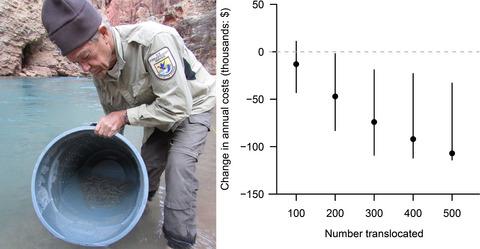当前位置:
X-MOL 学术
›
J. Appl. Ecol.
›
论文详情
Our official English website, www.x-mol.net, welcomes your
feedback! (Note: you will need to create a separate account there.)
Assessing the population impacts and cost-effectiveness of a conservation translocation
Journal of Applied Ecology ( IF 5.0 ) Pub Date : 2021-05-11 , DOI: 10.1111/1365-2664.13908 Charles B. Yackulic 1 , David R. Van Haverbeke 2 , Maria Dzul 1 , Lucas Bair 1 , Kirk L. Young 2
中文翻译:

评估保护易地的人口影响和成本效益
更新日期:2021-05-11
Journal of Applied Ecology ( IF 5.0 ) Pub Date : 2021-05-11 , DOI: 10.1111/1365-2664.13908 Charles B. Yackulic 1 , David R. Van Haverbeke 2 , Maria Dzul 1 , Lucas Bair 1 , Kirk L. Young 2
Affiliation

|
- Managers often move, or translocate, organisms into habitats that are assumed to be suitable; however, the consequences of these translocations are usually not rigorously assessed. Robust assessment of these management experiments should consider impacts to both donor and recipient populations and compare the cost-effectiveness of translocations to other actions.
- Here we evaluate the translocations of a federally listed fish species, humpback chub within a tributary to the Colorado River in its Grand Canyon reach (Arizona, USA). We analyse mark–recapture data with multistate models to estimate vital rates (growth, survival and movement) for the donor and recipient populations while accounting for substantial temporal variation in vital rates. We then use stochastic matrix projections to quantify the impact of translocations on adult population size. Lastly, we compare the costs of translocations to another, legally required management action, non-native fish removal, by modifying an existing bioeconomic model.
- We estimate that six of eight translocations during the study period positively impacted adult abundance and that the overall population impact was positive. Population projections suggest that each chub translocated per year increases the equilibrium adult population size by 1.2 (95% CI: 0.4–2.2) adults, lessening the need for non-native fish removal.
- The continuation of translocations at the current rate is expected to save managers ~$50,000 per year by decreasing the annual probability of removals from 0.26 to 0.15. Further savings and decreases in removals could be attained by avoiding translocations in years when there has been no winter/spring runoff and modifying the number of translocated individuals based on the estimates of juvenile production in the lower Little Colorado River.
- Synthesis and applications. Translocations that increase the abundance of a rare species can sometimes be viewed as a hedge against future declines that might necessitate more costly interventions. Quantifying population benefits and economic costs of management actions like translocations and comparing alternative actions can lead to cost-effective conservation that is more easily sustained.
中文翻译:

评估保护易地的人口影响和成本效益
- 管理人员经常将生物移动或转移到认为合适的栖息地;然而,这些易位的后果通常没有得到严格评估。对这些管理实验的稳健评估应考虑对捐赠者和接受者群体的影响,并将易地与其他行动的成本效益进行比较。
- 在这里,我们评估了在其大峡谷河段(美国亚利桑那州)的科罗拉多河支流内的一种联邦列出的鱼类,即驼背鲢的易位。我们使用多状态模型分析标记-重新捕获数据,以估计供体和受体群体的生命率(生长、存活和移动),同时考虑生命率的显着时间变化。然后我们使用随机矩阵预测来量化易位对成年人口规模的影响。最后,我们通过修改现有的生物经济模型,将易地成本与另一种法律要求的管理行动、非本地鱼类去除进行了比较。
- 我们估计研究期间八次易位中的六次对成年丰度产生了积极影响,并且总体人口影响是积极的。种群预测表明,每年每转移一个鲢鱼,平衡成鱼种群规模增加了 1.2(95% CI:0.4-2.2)成鱼,减少了去除非本地鱼类的需要。
- 以目前的速度继续进行易位,预计每年可将搬迁概率从 0.26 降低到 0.15,从而为管理人员节省约 50,000 美元。通过在没有冬季/春季径流的年份避免易地并根据小科罗拉多河下游幼鱼产量的估计修改易地个体的数量,可以进一步节省和减少清除量。
- 合成与应用。增加稀有物种丰度的易位有时可以被视为对未来可能需要更昂贵干预措施的减少的对冲。量化人口收益和管理行动(如易地)和比较替代行动的经济成本可以导致更容易维持的具有成本效益的保护。











































 京公网安备 11010802027423号
京公网安备 11010802027423号